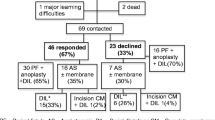Abstract
Sixteen patients who had undergone secondary posterior sagittal anorectoplasty (PSARP) for fecal incontinence were clinically followed for 3 to 10 years (mean 5.8). In addition to preoperative manometric evaluation, postoperative anorectal manometry was performed on all patients 1–3 times. Fourteen of the 16 patients underwent postoperative biofeedback training. At the last follow-up visit, the mean age of the patients was 18.3 years (range 16–26). Fectal continence improved in 13 patients. Manometrically measured, both the squeeze and resting pressures in the anal canal were significantly increased. Biofeedback facilitated the improvement of continence in 10 of the 14 patients. However, at the last follow-up, only 4 had good fecal continence with voluntary bowel movements and only occasional soiling. Three patients had voluntary bowel movements but frequent soiling; 8 used daily enemas to stay clean and 1 has a permanent colostomy. Secondary PSARP improves fecal continence in patients with intractable incontinence following primary repair of anorectal anomalies, but in adulthood it is good in only a minority of cases. Most patients require adjunctive measures to maintain socially acceptable bowel function.
Similar content being viewed by others
References
Vries P de, Pena A (1982) Posterior sagittal anorectoplasty. J Pediatr Surg 17: 638–643
Brain AJL, Kiely EM (1989) Posterior sagittal anorectoplasty for reoperation in children with anorectal malformations. Br J Surg 76: 57–59
Brandesky G, Holschneider AM (1976) Operations for the improvement of fecal continence. Prog Pediatr Surg 9: 105–114
Grotte G, Hakelius L, Frykberg T, Rasmundsson T (1984) Nine years of free autogenous muscle transplantation for anal incontinence in children. Z Kinderchir [Suppl I] 39: 80–82
Holschneider AM (1983) Elektromanometrie des Enddarms. Urban & Schwarzenberg, Munich Wien Baltimore, pp 213–218
Kiesewetter WB (1977) Imperforate anus: a five to thirty year follow-up perspective. Prog Pediatr Surg 10: 110–120
Kottmeier PK, Velcek FT, Klotz DH, Coren CV, Hansbrough F, Price AP (1986) Results of levatorplasty for anal incontinence. J Pediatr Surg 21: 647–650
Langemeijer RATM, Molenaar JC (1991) Continence after posterior sagittal anorectoplasty. J Pediatr Surg 26: 587–590
Pena A (1983) Posterior sagittal anorectoplasty as a secondary operation for the treatment of fecal incontinence. J Pediatr Surg 18: 762–772
Pena A (1988) Posterior sagittal anorectoplasty: results in the management of 332 cases of anorectal malformations. Pediatr Surg Int 3: 94–104
Rintala R, Lindahl H, Marttinen E, Sariola H (1993) Constipation is a major functional complication after internal sphincter-saving posterior sagittal anorectoplasty for high and intermediate anorectal malformations. J Pediatr Surg 28: 1054–1058
Rintala R (1990) Postoperative internal sphincter function in anorectal malformations — a manometric study. Pediatr Surg Int 5: 127–130
Schweiger M (1979) Method for determining individual contributions of voluntary and involuntary anal sphincters to resting tone. Dis Colon Rectum 22: 415–416
Shandling B, Gilmour RF (1987) The enema continence catheter in spina bifida: successful bowel management. J Pediatr Surg 22: 271–273
Stephens FD, Smith ED (1988) Anorectal malformations in children: update 1988. In: Birth defects: Original article series, vol. 24, no. 4. Alan R. Liss, New York, pp 481–500
Templeton JM, Ditesheim JA (1985) High imperforate anus — quantitative results of long-term fecal continence. J Pediatr Surg 20: 645–652
Willital GH (1983) Der künstliche Enddarmverschluss (SSE-Implantat) — 6-Jahres Ergebnisse. In: Hofmann-v. Kappherr S (ed) Anorektale Fehlbildungen. Gustav Fischer, Stuttgart New York, pp 219–221
Author information
Authors and Affiliations
Rights and permissions
About this article
Cite this article
Rintala, R.J., Lindahl, H. Secondary posterior sagittal anorectoplasty for anorectal malformations. Pediatr Surg Int 10, 414–417 (1995). https://doi.org/10.1007/BF00182245
Accepted:
Issue Date:
DOI: https://doi.org/10.1007/BF00182245




